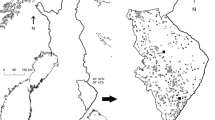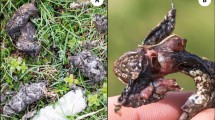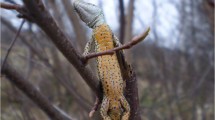Abstract
Intraguild predation (IGP) has been explained in terms of competitor-removal, food-stress and predator-removal hypotheses. Only the first two hypotheses have been fairly well studied. To test the predator-removal hypothesis as a force determining IGP in avian predators, we performed a field experiment to simulate the presence of an IG predator (eagle owl Bubo bubo dummy) in the surrounding of the nests of four potential IG prey (black kite Milvus migrans, red kite Milvus milvus, booted eagle Aquila pennata and common buzzard Buteo buteo). To discard the possibility that an aggressive reaction towards the eagle owl was not related to the presence of the IG predator, we also presented a stuffed tawny owl Strix aluco, which is a potential competitor but cannot be considered an IG predator of the studied diurnal raptors considered in the experiment. While almost always ignoring the tawny owl, raptors chiefly showed an interspecific aggressive behaviour towards their IG predator. Our results seem to support the predator-removal hypothesis, as the IG prey may take advantage of the diurnal inactivity of the IG predator to remove it from their territory. However, the recorded behaviour may be also considered as a special variety of mobbing (i.e. a prey’s counter-strategy against its predator), where the mobber is sufficiently powerful to escalate predator harassment into deliberate killing attempts. In their turn, eagle owls can respond with an IG predatory behaviour aimed at removing IG prey species which are highly aggressive mobbers.

Similar content being viewed by others
References
Alcock J (1998) Animal behavior: an evolutionary approach. Sinauer Associates, Sunderland
Bates D, Maechler M (2009) lme4 — Linear mixed-effects models using S4 classes. Version 0.999375-31. http://lme4.r-forge.r-project.org/
Bolker BM, Brooks ME, Clark CJ, Geange SW, Poulsen JR, Stevens MHH, White JSS (2008) Generalized linear mixed models: a practical guide for ecology and evolution. Trends Ecol Evol 24:127–135. doi:10.1016/j.tree.2008.10.008
Caro TM, Stoner CJ (2003) The potential for interspecific competition among African carnivores. Biol Conserv 110:67–75. doi:10.1016/S0006-3207(02)00177-5
Crooks KR, Soulé ME (1999) Mesopredator release and avifaunal extinctions in a fragmented system. Nature 400:563–566. doi:10.1038/23028
Hakkarainen H, Korpimäki E (1996) Competitive and predatory interactions among raptors: an observational and experimental study. Ecology 77:1134–1142. doi:10.2307/2265582
Heithaus MR (2001) Predator–prey and competitive interactions between sharks (order Selachii) and dolphins (suborder Odontoceti): a review. J Zool 253:53–68. doi:10.1017/S0952836901000061
Johnson CN, Isaac JL, Fisher DO (2007) Rarity of a top predator triggers continent-wide collapse of mammal prey: dingoes and marsupials in Australia. Proc R Soc B 274:341–346. doi:10.1098/rspb.2006.3711
Korpimäki E, Norrdahl K (1989) Avian predation on mustelids in Europe 1: occurrence and effects of body size variation and life traits. Oikos 55:205–215
Krüger O (2002) Interactions between common buzzard Buteo buteo and goshawk Accipiter gentilis: trade-offs revealed by a field experiment. Oikos 96:441–452. doi:10.1034/j.1600-0706.2002.960306.x
Linnell JDC, Strand O (2000) Interference interactions, co-existence and conservation of mammalian carnivores. Divers Distri 6:169–176. doi:10.1046/j.1472-4642.2000.00069.x
Lourenço R, Santos SM, Rabaça JE, Penteriani V (2011) Superpredation patterns in four large European raptors. Pop Ecol 53:175–185. doi:10.1007/s10144-010-0199-4
Mikkola H (1976) Owls killing and killed by other owls and raptors in Europe. Br Birds 69:144–154
Palomares F, Caro TM (1999) Interspecific killing among mammalian carnivores. Am Nat 153:492–508. doi:10.1086/303189
Pavey CR, Smyth AK (1998) Effects of avian mobbing on roost use and diet of powerful owls, Ninox strenua. Anim Behav 55:313–318. doi:10.1006/anbe.1997.0633
Penteriani V, Delgado MM, Alonso-Alvarez C, Sergio F (2007) The importance of visual cues for nocturnal species: eagle owls signal by badge brightness. Behav Ecol 18:143–147. doi:10.1093/beheco/arl060
Penteriani V, Lourenço R, Delgado MM (2008) El fenómeno de la colonización de Doñana por parte del búho real: patrones espacio-temporales de la población y efectos sobre las comunidades de aves y mamíferos. Final Report, C.S.I.C. – Junta de Andalucía, EXPTE.:700/2005/M/00.
Pettifor RA (1990) The effects of avian mobbing on a potential predator, the European kestrel, Falco tinnunculus. Anim Behav 39:821–827. doi:10.1016/S0003-3472(05)80945-5
Polis GA, Myers CA, Holt RD (1989) The ecology and evolution of intraguild predation: potential competitors that eat each other. Ann Rev Ecol Syst 20:297–330. doi:10.1146/annurev.es.20.110189.001501
R Development Core Team (2009) R: A language and environment for statistical computing. R Foundation for Statistical Computing, Vienna, Austria. ISBN 3-900051-07-0, URL: http://www.R-project.org
Ritchie EG, Johnson CN (2009) Predator interactions, mesopredator release and biodiversity conservation. Ecol Lett 12:982–998. doi:10.1111/j.1461-0248.2009.01347.x
Schmitz OJ, Hambäck PA, Beckerman AP (2000) Trophic cascades in terrestrial systems: a review of the effects of carnivore removals on plants. Am Nat 155:141–153. doi:10.1086/303311
Sergio F, Hiraldo F (2008) Intraguild predation in raptor assemblages: a review. Ibis 150(s1):132–145. doi:10.1111/j.1474-919X.2008.00786.x
Sergio F, Marchesi L, Pedrini P (2003) Spatial refugia and the coexistence of a diurnal raptor with its intraguild owl predator. J Anim Ecol 72:232–245. doi:10.1046/j.1365-2656.2003.00693.x
Sergio F, Marchesi L, Pedrini P, Penteriani V (2007) Coexistence of a generalist owl with its intraguild predator: distance-sensitive or habitat-mediated avoidance? Anim Behav 74:1607–1616. doi:10.1016/j.anbehav.2006.10.022
Sergio F, Blas J, Hiraldo F (2009) Predictors of floater status in a long-lived bird: a cross-sectional and longitudinal test of hypotheses. J Anim Ecol 78:109–118. doi:10.1111/j.1365-2656.2008.01484.x
Serrano D (2000) Relationship between raptors and rabbits in the diet of Eagle Owls in southwestern Europe: competition removal or food stress? J Raptor Res 34:305–310
Sih A, Crowley P, McPeek M, Petranka J, Strohmeier K (1985) Predation, competition, and prey communities: a review of field experiments. Ann Rev Ecol Syst 16:269–311. doi:10.1146/annurev.es.16.110185.001413
Slagsvold T (1982) Mobbing: goshawks attacking stuffed eagle owl. Br Birds 75:330–333
Suárez S, Balbontín J, Ferrer M (2000) Nesting habitat selection by booted eagles Hieraaetus pennatus and implications for management. J Appl Ecol 37:215–223. doi:10.1046/j.1365-2664.2000.00503.x
Sunde P, Overskaug K, Kvam T (1999) Intraguild predation of lynxes and foxes: evidence of interference competition? Ecography 22:521–523. doi:10.1111/j.1600-0587.1999.tb01281.x
Sunde P, Bølstad MS, Desfor KB (2003) Diurnal exposure as a risk sensitive behaviour in tawny owls Strix aluco? J Avian Biol 34:409–418. doi:10.1111/j.0908-8857.2003.03105.x
Tella JL, Mañosa S (1993) Eagle owl predation on Egyptian vulture and northern goshawk: possible effects of a decrease in European rabbit availability. J Raptor Res 27:111–112
Zar JH (1999) Biostatistical analysis. Prentice Hall, New Jersey
Zuberogoitia I, Martínez JE, Martínez JA, Zabala J, Calvo JF, Azkona A, Pagán I (2008) The dho-gaza and mist net with Eurasian eagle-owl (Bubo bubo) lure: effectiveness in capturing thirtheen species of European raptors. J Raptor Res 42:48–51. doi:10.3356/JRR-05-31.1
Acknowledgements
We thank F. Goytre, C. Lee-Ray and Tiffany for their help in field work, S. Santos for statistical advice and revision, and E. Korpimäki, J. Valkama and an anonymous referee for useful comments that improved the manuscript. The study was funded by a research project from the Consejería de Medio Ambiente, Junta de Andalucía (EXPTE.:700/2005/M/00./). RL was supported by a doctoral degree grant from Fundação para a Ciência e Tecnologia, Portugal (BD/27434/2006), VP by a grant from the Ministry of Education and Science, C.S.I.C. (Proyectos Intramurales Especiales), and a grant from the Spanish Secretaría General de Universidades, Ministry of Education (Salvador de Madariaga Program), and MMD by a postdoctoral grant from the Spanish Ministry of Science and Innovation and a post-doctoral grant from the Academy of Finland.
Author information
Authors and Affiliations
Corresponding author
Additional information
Communicated by E. Korpimäki
Rights and permissions
About this article
Cite this article
Lourenço, R., Penteriani, V., Delgado, M.M. et al. Kill before being killed: an experimental approach supports the predator-removal hypothesis as a determinant of intraguild predation in top predators. Behav Ecol Sociobiol 65, 1709–1714 (2011). https://doi.org/10.1007/s00265-011-1178-2
Received:
Revised:
Accepted:
Published:
Issue Date:
DOI: https://doi.org/10.1007/s00265-011-1178-2




